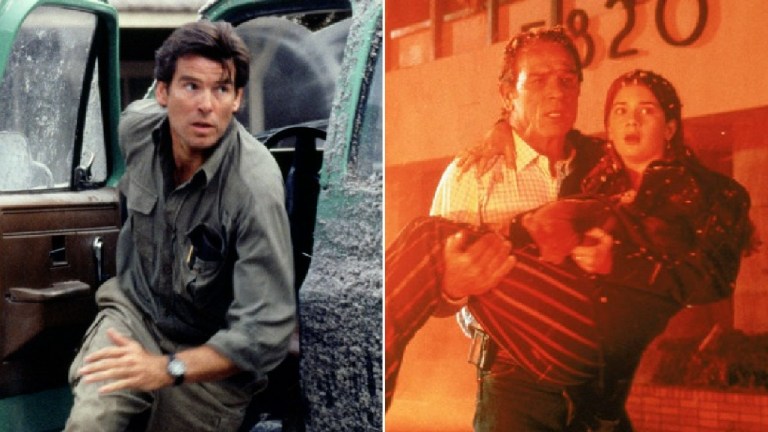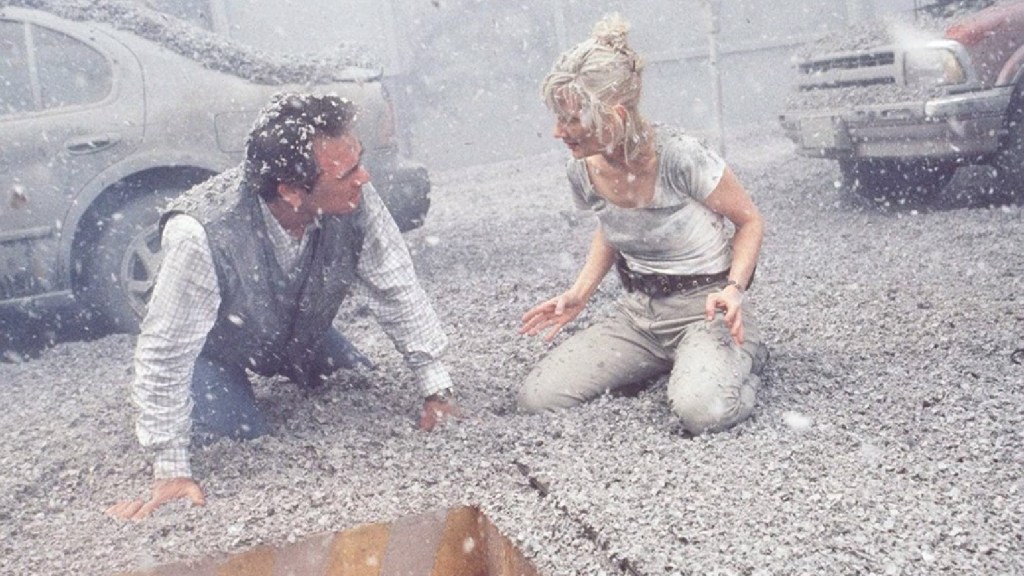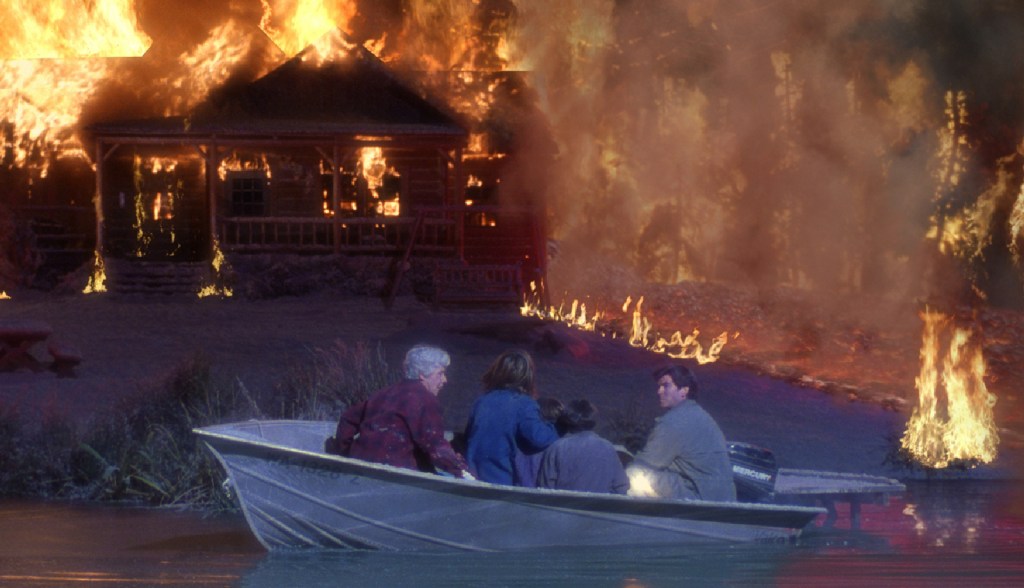Volcano vs. Dante’s Peak: Which Is the Better Disaster Flick?
Two volcano movies erupted onto screens in 1997: Dante's Peak and Volcano. Which gave better lava?

It was 25 years ago that several Hollywood studios indulged in the town’s occasional and curious practice of releasing two movies about the same subject within months of each other, if not weeks.
On Feb. 7, 1997, Universal Pictures released Dante’s Peak, in which Pierce Brosnan and Linda Hamilton try to save a small Washington town from being obliterated by a long dormant and suddenly active volcano. Just over two months later, on April 25, 1997, 20th Century Fox delivered Volcano, with Tommy Lee Jones and Anne Heche leading the efforts to stop a newly formed underground vent from erupting and wiping out all of Los Angeles.
Both films were also part of the genre known as the disaster movie, which arguably peaked in the mid-1970s with hits like The Poseidon Adventure, Earthquake, and the gold standard for the category, 1974’s The Towering Inferno (which was actually nominated for Best Picture at that year’s Oscars). Since that golden age, the genre has only occasionally raised its head, often as direct-to-video timewasters. But the mid-to-late 1990s was a different story.
Released during the genre’s second coming for the new CGI era, neither Dante’s Peak nor Volcano were particularly successful with either critics or moviegoers (more on that later), but in the ensuing quarter-century since their release, both have cultivated their own sets of fans who argue over each film’s relative merits (or lack thereof). With all that in mind, we decided to take a look at both and see which one, to fully use the pun, blows us away the most.
The Plot: Small Town Terror vs Big City Spectacle
Dante’s Peak takes place in the titular town in rural Washington state, voted the second-best place to live in the U.S. (that will change all too soon) and nestled in a beautiful forest at the base of the long-dormant volcano that gives the village its name. U.S. Geological Survey volcanologist Harry Dalton (Brosnan)—who lost his co-worker/lover in a violent eruption in Colombia four years earlier—is dispatched to look into some unusual activity detected around the mountain.
While getting friendly with Mayor Rachel Wando (Hamilton) and her kids, Dalton becomes alarmed by a series of events that include two campers getting scalded to death in a local hot spring, animals turning up dead around the mountain, and more. He’s joined by the rest of his USGS team, but his boss Paul (Charles Hallahan) is reluctant to issue an emergency alert and panic the town, especially when no flagrant signs of imminent volcanic activity are detected.
His caution is shortsighted, however, and halfway through the movie, Dante’s Peak does blow in spectacular fashion, raining destruction upon the town as its citizens attempt to flee. Meanwhile Dalton and Wando must drive up the mountain to save Wando’s children, who are on a mission to extract their stubborn, reclusive grandmother from her hillside lodge.
Directed by Roger Donaldson (who helmed Species and the underrated Thirteen Days), Dante’s Peak is more of a slow burn, with the script and director trying to build an atmosphere of suspense and dread before unleashing the special effects and action. There’s also more of an attempt at character development, which, awkward as it is, kind of works thanks to the natural charm of Brosnan and Hamilton.
When the final third of the movie boils down (so to speak) to their predicament (they end up trapped in a mine as the mountain collapses around them), viewers may actually find themselves concerned for their well-being—although the two little kids driving up the mountain (in a standard shift vehicle, no less) to rescue Grandma is a pretty inane plot development in the first place.
Volcano, meanwhile, offers little build-up or character development whatsoever. We know that Tommy Lee Jones is a single dad whose daughter is conveniently visiting him for the week, but that’s about it. And we know almost nothing else at all about the other characters, which is a shame because the ensemble cast of established character actors and rising stars here is much more exciting and watchable than that of Dante’s Peak.
Jones plays Mike Roark, head of L.A.’s Office of Emergency Management, and just as he’s starting a week off with his daughter, the trouble begins: earthquakes rock the city while the pond in Griffith Park and the La Brea Tar Pits inexplicably begin to heat up.
As the latter explode, sending “lava bombs” into the streets like missiles, and as a river of molten rock begins to flow inexorably down Wilshire Boulevard, seismologist Amy Barnes (Heche) confirms the unbelievable: a volcano has formed under the City of Angels and could blow the town straight up to the sky.
From that point on, it’s all action, all the time, as Roark (Jones in full, take-charge The Fugitive/U.S. Marshals mode) barks commands, runs through the streets, and basically does everything he can to mobilize the city’s resources and stop L.A. from turning into a modern-day Pompeii, all while also trying to rescue his daughter (Gaby Hoffman), who finds herself in danger mainly because the script demands it.
In terms of plot, Dante’s Peak is probably the more involving because it spends some nominal time getting to know its characters before putting them through literal hell. On the surface, Volcano may be the more immediately gripping picture because it starts at 80mph and never slows down, with more overall spectacle, but it doesn’t hold up as well on repeated viewings.

The Cast: James Bond vs. Two-Face
Pierce Brosnan had earned acclaimed for his first James Bond outing, GoldenEye, just two years earlier and was in full-on action hero mode when it came time to make Dante’s Peak. But while the film doesn’t exactly stretch his range, he does manage to imbue Harry Dalton with some nuance.
The man is still haunted by the death of his lover four years earlier, but he doesn’t sit and brood like a lot of movies might have him do. He hangs out with his colleagues and is open to new romance. He’s also not invincible; Harry makes mistakes, shows real fear and gets quite badly injured during the third act.
He’s aided capably by Hamilton, also doing her best to give some layering to the role of the single-mom mayor (who also owns the town’s best coffee shop), but the rest of the cast is not very recognizable (the late Hallahan excepted_. Look for Grant Heslov, future producing partner of George Clooney, in a small role as one of Harry’s fellow USGS team members.
As noted earlier, Jones—two years after ingesting the scenery as Harvey “Two-Face” Dent in Batman Forever—is in gruff, commanding form in Volcano and rarely veers from it, showing some doubt and fear only late in the film. But while the cast here is much more fun to watch in terms of picking out recognizable faces, the acting is occasionally let down by the skimpier script.
Heche is okay as Dr. Exposition (although the death of her lesbian colleague early in the film hints at a subplot that’s never fully fleshed out), but you can also watch a young Don Cheadle (prior to his breakout role in Boogie Nights later that year), a reliable John Carroll Lynch (Zodiac), and an always watchable Keith David (The Thing) strut their stuff as well.
(By the way, watch the end credits scroll to spot a pre-Marvel Studios Kevin Feige listed as assistant to producer Lauren Shuler Donner, in what may be his first professional onscreen credit.)
Which cast is better? It’s kind of a wash. The ensemble in Volcano is more glittering, but the troupe in Dante’s Peak arguably gets better material to work with.
Which One Could Really Happen?
We’re not going to break down the science of volcanoes (not that we know much about it), but it seems clear that Dante’s Peak, which was inspired partially by the eruption of Mount St. Helens in 1980, easily wins the prize here.
The real-life USGS devoted an entire page to the movie’s depiction of events, concluding that the picture actually hit “close to the mark” in many respects. The USGS acknowledged that the volcano portrayed in the film was very similar in many aspects to real volcanoes in the northwest United States, Canada, and Alaska, although other plot points—such as Brosnan driving an off-road vehicle over the cooling, crusty top of a lava flow—were deemed “likely to lead to disaster.”
Volcano, on the other hand, was wildly implausible from the get-go, with the studio and producers not even trying to pretend that there was any scientific accuracy to their picture (Universal took the opposite tact with Dante’s Peak). Even the science adviser on Volcano said he “bit his lip” but kept quiet when it came to things like lava flowing uphill on Los Angeles streets. He also admitted that any eruption under the streets of Los Angeles like the kind depicted in the movie was several million years in the future, if it were to ever happen at all.
Neither film is going to win an award for scientific accuracy, but Dante’s Peak clearly towers over Volcano in this regard.

The Special Effects, Dogs and Deaths
Neither movie has aged especially well in terms of visual effects, but we do have to give the nod once again to Dante’s Peak.
On the big screen back in 1997, glowing, flaming lava churning through the streets of Los Angeles, erupting in sudden geysers, looked pretty cool. But the CGI used to make most of that happen just doesn’t hold up now, and the lava itself moves so fast that it seems like a kind of red-hot version of The Blob more than a natural occurrence. A climactic scene of Tommy Lee Jones running and jumping to get his daughter and another kid out of the way of a collapsing building also looks incredibly hokey today.
Plus, there’s no actual volcano, so to speak, in the movie bearing that title: it’s all underground. The movie instead makes the lava flow the focal point rather than the kind of towering edifice that we think of when we imagine what a real-life eruption.
That’s why Dante’s Peak wins here: the volcano is massive and impressive, lending credibility to the events of the film, and its explosive eruption—while also limited by the effects of the time—appears more realistic. The destruction it brings to the town also seems more plausible in the context of the film, with lava and rubble streaming down the slopes of the mountain, as opposed to the volcano in Volcano firing off those lava bombs through manhole covers.
Both films also feature specific, similar narrative beats, starting with the rescue of a dog. The dog in Dante’s Peak belongs to the Wando kids’ grandmother and is left behind during her rescue. As Brosnan drives the family back down the mountain ahead of the lava flow, the pooch inexplicably shows up on a rock on the side of the road and manages a perfectly-timed leap into the back of the truck. It’s meant as a real crowdpleaser moment, but comes off as cheesy.
The dog’s rescue in Volcano is much more mundane: as a woman screams outside her burning house for her dog to come out, the terrified pup keeps finding himself blocked by the flames before suddenly realizing that the pet hatch in the kitchen door is readily accessible. He saunters through and runs into the arms of his waiting owner.
Both films also feature the horrific if ostensibly noble death of a key supporting character. In Dante’s Peak, Brosnan, Hamilton, her kids, and Grandma must ditch their burning truck and take a motorboat across a lake that’s turned into acid. It’s a pretty harrowing sequence, actually, as the boat dissolves beneath their feet, the motor dies, and Grandma jumps into the acid to push the boat the last few feet to shore, fatally and agonizingly injuring herself in the process. But at least she saves the main characters.
In Volcano, on the other hand, MTA head John Carroll Lynch rescues an injured conductor from a subway car but must jump into the magma surrounding the car and throw the conductor to safety before both are consumed. Lynch’s horrifying death is negated by the fact that the lava around him looks utterly fake as he sinks into it, plus the conductor, the subway, and the MTA’s efforts are not really crucial to the story and Lynch’s death is never mentioned again.
And The Winner Is…
Let’s face it: Dante’s Peak and Volcano are both pretty silly movies. But the former takes itself more seriously, while the latter—directed by Mick Jackson (who made the shocking nuclear war movie Threads in 1984 for the BBC)—almost seems more aware of just how dumb its premise and accompanying action sequences are.
Although Volcano seemed to have the bigger scope and more bang for its buck in theaters 25 years ago, we ultimately have to give the edge to Dante’s Peak as the better movie. It’s more involving, its characters are better developed, and its disaster seems more plausibly conceived and executed, even if it’s less over-the-top than its competitor.
No one seemed like either much at the time of their release: critics were mixed on Volcano, awarding it a retroactive 50 percent “rotten” rating on Rotten Tomatoes while the better Dante’s Peak strangely earned just a paltry 28 percent in reviews.
On a budget of $90 million, Volcano earned just $123 million worldwide, including a meager $49 million in North America. Dante’s Peak fared somewhat better, with a global haul of $178 million (including $67 million in North America), but it also reportedly cost more with a price tag of $116 million. The bottom line: neither movie was a success.
That doesn’t mean that Hollywood wasn’t willing to throw similar movies into head-to-head competition again, however: the very next year, 1998, brought us the dueling big-budget meteor movies Deep Impact and Armageddon. But that’s another disaster story…
